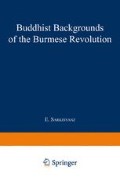Abstract
Burma’s conqueror kings too were influenced by such visions of an ideal Buddhist world state through which Dhamma Morality was to be extended to the whole world and the golden age restored.1 Against this background, Tabin Shwehti (1531–1550), founder of the Second Burmese Empire (cf. p. 7), also sought to become a Cakkavattî.2 Yet it was not before his indecisive invasion that he offered peace to Siam, with the statement that he aspired to become a Buddha in a subsequent life:3 “Thus, royally deigning very appropriately to enjoy the appearance of ... a Cakkavattî, of the Sovereign of the Four Great Islands [cf. p. 82f.], ... it was only [for] victory over Mâra (Evil) that the exalted army deigned to descend [hcạ] [upon Siam].”4
Access this chapter
Tax calculation will be finalised at checkout
Purchases are for personal use only
Preview
Unable to display preview. Download preview PDF.
References
D. G. E. Hall, Burma [Hutchinson’s University Library, British Empire Series: (London, 1950)], p. 41.
Hman nan: Maha Yazawin-to-gyi:, Duti-twe (Mandalay, 1319/1957), p. 414.
U: Kala, Maha Yazawin-gyi:, Vol. II (Rangoon, no date, Edition of Saya Pwa), pp. 243f.
See note 2, supra.
Cf. H. Quaritch Wales, Siamese State Ceremonies (London, 1931), pp. 31f. The Dharma Çakra, symbol of the Chakravartin (Cakkavattî)-and already earlier the emblem of Ashoka-constitutes the coat of arms of the Republic of India. On its symbolism of the Solar Wheel : E. Senart, Essai sur la légende du Buddha (Paris, 1882), pp. 356–364.
Alaungpaya’s inscription at the Shwebo Pagoda, in: Archaeological Survey of Burma, Report of the Superintendent for 1923/1924 (Rangoon, 1924), p. 30.
Paññasâmi, Sâsanavaṃsa, VI, 123: transl. B. C. Law, p. 128.
Koun: baun-ze’ Maha Yazawin-to-gyi: (Mandalay, 1267/1905), p. 317.
Koun: baun-ze’ Maha Yazawin-to-gyi:, p. 315.
Ibid., p. 352.
G. Coedès, “Le 2500e Anniversaire du Bouddha,” in: Diogène, No. 15 (July, 1956), p. 127.
Cf. Archaeological Survey of Ceylon, Epigraphia Zeylanica, edited by M. de Zilva Wickremasingh, Vol. II (London, 1928), p. 274; Chullavagga, X, 6: Vinaya Texts translated from Pâli by T. W. Rhys Davids & H. Oldenberg, in: SBE, Vol. XX (1885), p. 325.
E. M. Mendelson, “A Messianic Buddhist Association in Upper Burma,” in: Bulletin of the London School of Oriental and African Studies, Vol. XXIV, Part iii (1961), p. 575.
W. A. R. Wood, History of Siam from the earliest times to the year 1781 (London, 1926), p. 269. Chao P’raya Dibakarawongse’s “History of the First Reign” (Bangkok, 1869) was not accessible to me, as it is in the Siamese language.
Mendelson, “A Messianic Buddhist Association in Upper Burma,” p. 572.
Nânâbhivamsadhamma senâpati, Râjadhirâja Vilâsinî: transl. by Maung Tin, in: JBRS, IV, i (1914), p. 18.
Koun: baun -ze’ Maha Yazawin-to-gyi: (Mandalay, 1905), p. 573.
Cf. M. Bode, Pâli Literature of Burma, p. 77.
Sangermano, A description of the Burmese Empire, 56, 59. Not accessible to me remained U : Yazinda, “Sâsanabahussuttappakâsani” which refers to this period of Bodawpaya’s reign. English accounts of the above have, so far, all been ultimately derived from Sangermano.
D. G. E. Hall (Editor), Michael Symes, Journal of his Second Embassy to the Court of Ava in 1802 (London, 1955), pp. xxvif., lxv.
Sangermano, A Description of the Burmese Empire, p. 56.
“Master of the Supernatural Weapon” (“Sakya” in John Crawfurd, Journal of an Embassy to the Court of Ava, Vol. I [London, 1834], p. 234, being probably a rendering of “Set-kya,”)
Crawfurd, Ibid., p. 268.
Mendelson, “A Messianic Buddhist Association in Upper Burma,” pp. 568f.
Crawfurd, op. cit., Vol. I, p. 304.
Including as recent a standard work as J. Cady, A history of modern Burma (Ithaca, 1960), pp. 77, fn. 26.
E. Sarkisyanz, Russland und der Messianismus des Orients. Sendungsbewusstsein und Chiliasmus des Ostens (Tübingen, 1955), p. 341.
Cûlavaṃsa, XCIX, 97: transl. W. Geiger, Part III, p. 264, fn. 3; Râjâvaliya, p. 43f.
“None shall suffer because of me. Let those who covet kingdoms seize mine if they will...” : Mahâsîlava-Jâtaka: Cowell, Jâtaka..., Vol. I, p. 130.
Shway Yoe, The Burman, his life and notions, p. 436.
Koun: baun ze’Maha Yazawin-to-gyi: (Rangoon, 1905), p. 986.
Paññasami, Sâsanavaṃsa, VI, 149, 151: transl. B. C. Law, pp. 150, 152.
W. L. Barreto, King Mindon (Rangoon, 1935), p. 46.
H. Yule, Mission to the Court of Ava, pp. 75, 141.
D. G. E. Hall, Burma (London, 1950), p. 117.
Than-sin (yahkin-to-paya: kale:), Thibaw Min: hsey atwin: ye: mya: (Rangoon, 1959), p. 5; cf. Howard Malcom, Travels in South-Eastern Asia ... and a full account of the Burmese Empire, Vol. I (Boston, 1839), p. 228.
Author information
Authors and Affiliations
Rights and permissions
Copyright information
© 1965 Springer Science+Business Media Dordrecht
About this chapter
Cite this chapter
Sarkisyanz, E. (1965). The Cakkavattî Ideal as a Factor in the Expansion and Fall of the Burmese Empire. In: Buddhist Backgrounds of the Burmese Revolution. Springer, Dordrecht. https://doi.org/10.1007/978-94-017-6283-0_15
Download citation
DOI: https://doi.org/10.1007/978-94-017-6283-0_15
Publisher Name: Springer, Dordrecht
Print ISBN: 978-94-017-5830-7
Online ISBN: 978-94-017-6283-0
eBook Packages: Springer Book Archive

